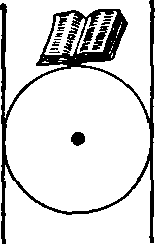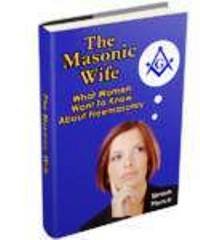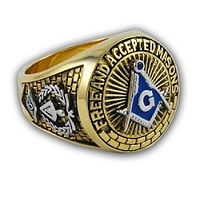Point Within A Circle
 Point Within a Circle
Point Within a Circle
What is the Masonic symbolism of the Point within a Circle?
This Masonic symbol has both a Modern symbolism and an Ancient symbolism. Some depictions show a "B" on the outer left side of the left vertical line for John the Baptist and an "E" on the outer right side of the right vertical line. The V.S.L. (Volume of Sacred Law) resides above the circle.
Modern Christian Symbolism Interpretation
The following excerpt is from the book, "Facts, Fables and Fantasies of Freemasonry, 1968, 5th Edition, 1993, by Rt. Ex. William Adrian Brown, Missouri Lodge of Research.
"The Point Within a Circle denotes St. John the Baptist, whose "day" is June 24th and St. John the Evangelist, whose "day" is December 27th. They are the 2 Patron Saints of Masonry.
While many Master Masons are aware of the celebration of these 2 days, few realize why it is cause for celebration within their lodge.
The Lodge of St. John was the primitive Mother Lodge, held in Jerusalem and dedicated to St. John, the Baptist and then to St. John the Evangelist and finally to both.
It is called the Lodge of the Holy Saints John of Jerusalem and from this lodge all other lodges descended."
End of excerpt from "Facts, Fables and Fantasies of Freemasonry".
The Saints John
Little is known about either of the Saints John in the Masonic sense. What we do know is that:
St. John the Baptist
St. John the Baptist was a stern and morally just man. He was a direct descendant from Ishmael's bloodline. (Ishmael was Abraham's eldest son, born by his servant, Hagar.) John's mother, Elizabeth was a relative of Mary, (Jesus' mother) and both John and Jesus were contemporaries (born about the same time).
John the Baptist baptized Jesus and proclaimed Him the "Lamb of God". John the Baptist is probably best known for his survivalist instincts, (as we read of his living off of locusts and honey) and for his zealous virtue in keeping God's laws.
St. John the Evangelist
St. John the Evangelist is said to be the disciple whom Jesus loved. St. John the Evangelist is also known as John the Apostle. He is probably best known as a teacher of knowledge, the author of the Gospel book of John, the book of Revelation in the New Testament and later wrote the 3 Epistles in the Bible called John 1, John 2 and John 3.
He was the only one of the 12 disciples who did not forsake Jesus at the hour of his death. He is remembered as a gentle teacher of brotherly love and was the last surviving apostle, and believed to have died at a very old age (90+), circa 101 A.D. at Ephesus, Turkey, which is about halfway between Jerusalem and Rome. At a later date, a church was built over his tomb and subsequently, a beautiful Moslem Mosque.
There is no historical evidence that either of the Saints John were ever members of the Craft of stonemasons, but because of their righteous lives and their strength of character, both of these Godly men have been adopted as the 2 Patron Saints of Masonry.
Masonic Symbolism of Point Within A Circle
The symbolism of the point within a circle is:
1. Point = The Individual Brother.
2. Circle= The boundary line of his
duty to God and to man,
beyond which a man should not allow his
passions, prejudices or interests to betray him.
Summer and Winter Solstices
In ancient times, festivals were held on these 2 days because they represent the days of the Summer and Winter Solstices, which illustrate cycles of life.
Today, our Summer Solstice is June 21st and our Winter Solstice is December 21st. These 2 festivals celebrated the times of both the first fruits in the Spring and the Fall harvest.
The Harvest
They also
represented the highest and lowest points which the sun reached. They
signify a time of celebrating the bountiful harvest of plenty that emerges from
the seeds of the Earth. In speculative Masonry, combined, they denote, in
essence, the celebration of reaping the fruits of your labor.
Point Within A Circle...Belongs to Nations
of Antiquity
It must be noted that the Point Within a Circle, like many of our Masonic symbols, did not originate in 1717, ...with the creation of the Grand Lodge of England,... nor did it originate from the stone masons of the Middle Ages, from whence we have evidence of their Old Charges, Old Constitutions and Old Charters.
This symbol is much older.
Links to the Past
These Masonic symbols such as the Sun, the Moon, the Blazing Star, the 47th Problem of Euclid and others are not specifically "Masonic" in nature, (meaning that they were not invented solely for use by the fraternity),... and yet, Freemasonry has embraced them,... and rightfully so. They must not be forgotten. They link modern man to our ancestors.
These symbols originate from ancient civilizations, long before even King Solomon's day...brought forward generation by generation via inculcation (teaching) and by the ancient monuments found to be inscribed with these symbols which Egyptologists, geologists and other scholars study in their attempts to understand Man's history.
Their findings reveal pieces of antiquity which some may find too deep, too mysterious or too sexual to be openly displayed before members of our present day brethren, some of whom may shun the knowledge of such.
Mankind's shared history around the globe is fascinating, nonetheless.
Point Within A Circle in Egypt
The 2 vertical lines on either side of the Point Within a Circle symbol date back before Solomon. (who lived nearly 1,000 years before John the Baptist was born.)
On early Egyptian monuments have been found the Alpha and Omega, (the symbol of God as the beginning and the end...or, therefore eternal), in the center of the circle bordered by 2 upright, perpendicular parallel serpents.
For some, the science and philosophy behind Masonic symbolism is viewed as Freemasonry's secrets, mysteries, or as a form of secret cultism known only to Freemason scholars. However, this is not true. For those who study attempting to find "Light", the science and philosophy behind Masonic symbolism can be found in Man's history. Masonic ritual, too, imitates these proud and ancient religious traditions.
Exoteric versus Esoteric
Exo-teric means external, outer knowledge or public knowledge. The above information is Exo-teric, or commonly believed by the general populace.
Eso-teric means mystical, metaphysical and more scholarly knowledge about a subject. Due to the nature of its subject matter,..the study of religions is Eso-teric.
Masonic Light
Therefore, for those who seek more Masonic Light about the Point Within A Circle, below is Brother Albert Mackey's (noted Masonic scholar and historian) more in depth and Esoteric (scholarly) explanation of this ancient symbol, the Point Within a Circle.
The Point Within a Circle
Ancient Symbolism Interpretation
The Point Within A Circle
The following information is credited to Albert Mackey, Freemason historian and scholar, from his book, "The Symbolism of Freemasonry: Illustrating and Explaining Its Science and Philosophy, Its Legends, Myths and Symbols.
"The Point within a Circle is another symbol of great importance in Freemasonry, and commands peculiar attention in this connection with the ancient symbolism of the universe and the solar orb.
Everybody who has read a Masonic "Monitor" is well acquainted with the usual explanation of this symbol. We are told that the point represents an individual brother, the circle the boundary line of his duty to God and man, and the two perpendicular parallel lines the patron saints of the order—St. John the Baptist and St. John the Evangelist.
Now, this explanation, trite and meagre as it is, may do very well for the exoteric teaching of the order; but the question at this time is, not how it has been explained by modern lecturers and Masonic system-makers, but what was the ancient interpretation of the symbol, and how should it be read as a sacred hieroglyphic in reference to the true philosophic system which constitutes the real essence and character of Freemasonry?
Perfectly to understand this symbol, I must refer, as a preliminary matter, to the worship of the Phallus, a peculiar modification of sun-worship, which prevailed to a great extent among the nations of antiquity.
The Phallus was a sculptured representation of the membrum virile, or male organ of generation, and the worship of it is said to have originated in Egypt, where, after the murder of Osiris by Typhon, which is symbolically to be explained as the destruction or deprivation of the sun's light by night, Isis, his wife, or the symbol of nature, in the search for his mutilated body, is said to have found all the parts except the organs of generation, which myth is simply symbolic of the fact, that the sun having set, its fecundating and invigorating power had ceased.
The Phallus, therefore, as the symbol of the male generative principle, was very universally venerated among the ancients, and that too as a religious rite, without the slightest reference to any impure or lascivious application.
He is supposed, by some commentators, to be the god mentioned under the name of Baal-peor, in the Book of Numbers, as having been worshipped by the idolatrous Moabites. Among the eastern nations of India the same symbol was prevalent, under the name of "Lingam." But the Phallus or Lingam was a representation of the male principle only. To perfect the circle of generation it is necessary to advance one step farther.
Accordingly we find in the Cteis of the Greeks, and the Yoni of the Indians, a symbol of the female generative principle, of co-extensive prevalence with the Phallus. The Cteis was a circular and concave pedestal, or receptacle, on which the Phallus or column rested, and from the centre of which it sprang.
The union of the Phallus and Cteis, or the Lingam and Yoni, in one compound figure, as an object of adoration, was the most usual mode of representation. This was in strict accordance with the whole system of ancient mythology, which was founded upon a worship of the prolific powers of nature.
All the deities of pagan antiquity, however numerous they may be, can always be reduced to the two different forms of the generative principle—the active, or male, and the passive, or female. Hence the gods were always arranged in pairs, as Jupiter and Juno, Bacchus and Venus, Osiris and Isis.
But the ancients went farther. Believing that the procreative and productive powers of nature might be conceived to exist in the same individual, they made the older of their deities hermaphrodite, (having both male and female genitalia) and used the term man-virgin, to denote the union of the two sexes in the same divine person.
Thus, in one of the Orphic Hymns, we find this line:...
"Jove was created a male and an unspotted virgin."
And Plutarch, in his tract "On Isis and Osiris," says, "God, who is a male and female intelligence, being both life and light, brought forth another intelligence, the Creator of the World."
Now, this hermaphrodism of the Supreme Divinity was again supposed to be represented by the sun, which was the male generative energy, and by nature, or the universe, which was the female prolific principle.
And this union was symbolized in different ways, but principally by the point within a circle, the point indicating the sun, and the circle the universe, invigorated and fertilized by his generative rays.
And in some of the Indian cave-temples, this allusion was made more manifest by the inscription of the signs of the zodiac on the circle.
So far, then, we arrive at the true interpretation of the Masonic symbolism of the point within a circle. It is the same thing, but under a different form, as the Master and Wardens of a lodge. The Master and Wardens are symbols of the sun, the lodge of the universe, or world, just as the point is the symbol of the same sun, and the surrounding circle of the universe.
But the two perpendicular parallel lines remain to be explained. Every one is familiar with the very recent interpretation, that they represent the two Saints John, the Baptist and the Evangelist. But this modern exposition must be abandoned, if we desire to obtain the true ancient signification.
In the first place, we must call to mind the fact that, at two particular points of his course, the sun is found in the zodiacal signs of Cancer (June) and Capricorn (December).
These points are astronomically distinguished as the summer and winter solstice. When the sun is in these points, he has reached his greatest northern and southern declination, (a gradual falling off from a higher state) and produces the most evident effects on the temperature of the seasons, and on the length of the days and nights.
These points, if we suppose the circle to represent the sun's apparent course, will be indicated by the points where the parallel lines touch the circle, or, in other words, the parallels will indicate the limits of the sun's extreme northern and southern declination, when he arrives at the solstitial points of Cancer and Capricorn.
But the days when the sun reaches these points are, respectively, the 21st of June and the 22d of December, and this will account for their subsequent application to the two Saints John, whose anniversaries have been placed by the church near those days."
End of Albert Mackey's dissertation on the Point
Within A Circle.
Within the symbol meaning of the Point Within a Circle we also see evidence of:
Logic, the 3rd of the 7 Liberal Arts and Sciences.
Geometry, the 5th of the 7 Liberal Arts and Sciences
Astronomy, the 7th of the 7 Liberal Arts and Sciences
Masonic Education Builds Masonic Retention
Related Pages:
5 Fast Methods To Find the Information You Want to Learn About
- Search Box - Use the Search Box at the top of your page.
- Site Map - Use my Site Map page to find the topics you are most interested in.
- Carousel - Use the carousel of pages at the top of your screen.
- Menu Icon - On MOBILE, click the MENU button at the top of each page.
- Masonic Books - Browse through a selection of Masonic books.






